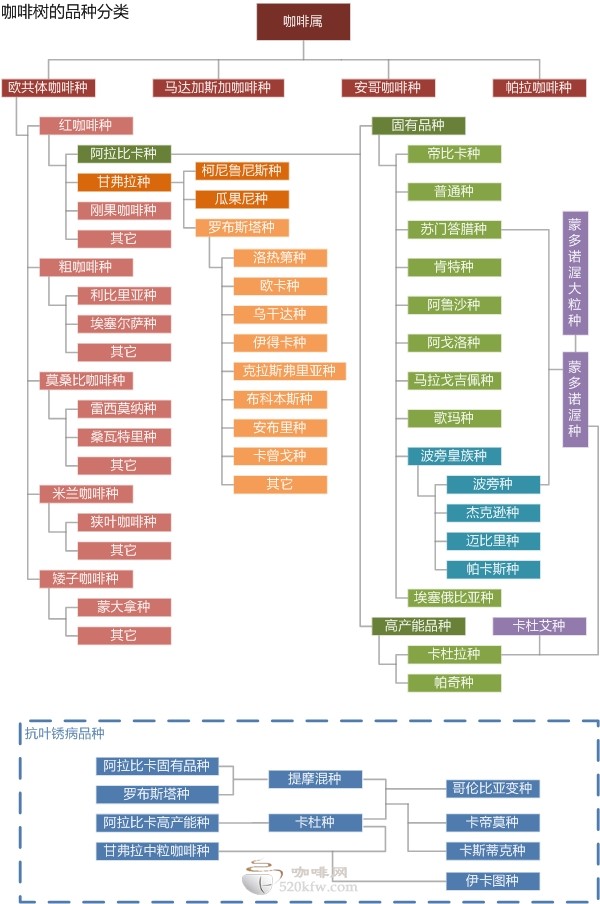Selection of basic Coffee Tree Classification

Arabica coffee and variety improvement
1. Arabica varieties
What does the so-called "family, genus, species" mean in biological classification? From the biological classification, from top to bottom are respectively "kingdom, phylum, class, order, family, genus, species","species" below and then divided into subspecies, varieties, varieties. Arabica coffee is generally believed to originate from the Ethiopian plateau and is widely distributed in tropical regions. After repeated mutation and breeding, many varieties have been derived. Now, it is said that there are more than 70 varieties of Arabica coffee alone. The so-called "variety", take rice, is the difference between Thai rice and Northeast China rice. Coffee, like rice, comes in many varieties. At the same time, coffee is the same as rice in variety improvement, and it is also constantly seeking to improve disease resistance, yield and environmental adaptability. In addition, rice also pursues variety improvement in taste. In order to pursue production efficiency, coffee pays less attention to this point, and the quality improvement of coffee taste has become a secondary consideration, and even "deterioration" is suspected. However, the market for high-quality coffee, that is, fine coffee, is still increasing, and coffee producing and consuming countries are constantly introducing new quality evaluation standards. Coffee with high evaluation and can be sold at a high price, the inherent varieties of wet Arabica species (or "old trees"), such as Typica, Bourbon, Caturra (Bourbon mutant), etc. In today's production varieties, the traditional varieties have the lowest yield and disease resistance, but their rich flavor cannot be replaced.
Several major coffee varieties and their characteristics
Typica
It is the closest of all Arabica species to the original species, from which almost all Arabica species derive. Formerly widely cultivated in Central and South America, the bean is long and has excellent aroma and acidity, but it is not tolerant of leaf rust and requires considerable shade trees resulting in low yields (like bourbon, harvested only once every two years). In Colombia, until 1967, the Tibica variety was grown exclusively; 80 to 90 percent are now grown with the high-yield, sunlight-tolerant Cardura or the Colombia variety. At present, there are very few pure Tibica on the coffee market in Colombia.
Bourbon
Tibica is the superior subspecies closest to the original Arabica, while Bourbon is the subspecies produced by Tibica mutation. Both are the oldest surviving coffee varieties. Bourbon was transplanted from Yemen to the east of Madagascar in East Africa, then to Bourbon Island (now called Reunion Island) in the Indian Ocean, and then to Brazil with French colonists. It is characterized by small and round beans, mostly densely clustered, so the central line is S-shaped.
Bourbon harvests 20% to 30% more than Tibicar, but less than other high-yielding varieties, and it harvests only once every two years, so it is gradually replaced by other varieties. Mondo Novo, Catuai and other bourbon hybrids and mutants have high aroma and body quality, and also have the characteristics of Tibica.
Caturra
This is a bourbon mutant found in Brazil with low tree height, small bean grains, large yield and resistance to leaf rust. The disadvantage is that it will only bear fruit in the next year, that is, it will only harvest once every two years. Although the quality is extremely high, the cost of care and fertilization is quite high, suitable for cultivation in the middle and high land with an altitude of 450~1700 meters and an annual rainfall of 2500~3500 mm. It is characterized by rich acidity and slightly astringent taste.
Mundo Novo
Natural hybrid of bourbon and sumatran species found in brazil. Environmental adaptability and pest resistance, although a high-yield varieties, but slow growth, beans particles on the large side. The height of the tree above 3 meters is its disadvantage (this height has exceeded the height that the harvester can reach, so it is not suitable for the mechanization of coffee harvesting), and the top branches of the coffee tree must be pruned every year. Cultivated in Brazil since about 1950, it is now the main Brazilian variety along with Kadura and Kaduai. Mondo Nove has a good balance of acid and bitterness, and its taste is close to the original variety, so it has just been sought after by everyone, and it is named "Mundo Nove"(New World).
Catuai
Mondonovo-cadura hybrid. High yield and environmental adaptability, tall trees (because Mondonovo trees are too tall, resulting in harvest difficulties, so they are crossed with tall trees). Unlike Kadura, Kaduai bears fruit every year. Although it must be fully fertilized, it is resistant to pests and diseases, and the fruit is not easy to fall in the face of strong wind and rain. However, its fruit growth and harvest life is only about ten years, and its short life is its weakness. Mainly cultivated in a wide area from Colombia to Central America. Carduai has a duller flavor than Mondonovo and lacks body.
Maragogype
This is a mutant of tibica found in brazil. Beans particles are large and need to be filtered with a sieve above 19. Taste some poor, but the appearance of good selling, it is favored by part of the market. The trees are tall, so the yield is low.
Kent
Indian variety. High yield and resistance to diseases, especially leaf rust. It is believed to be a hybrid of Tibica and other varieties.
Amarello
Generally, coffee fruits ripen red, but this variety of coffee fruit, as its name (Amarello comes from the modern Latin Amprellus, meaning "yellow"), ripens yellow. The trees are tall, so the yield is high.
Catimor
Born in Portugal in 1959, Timo (a hybrid of Arabica and Robusta), which is highly resistant to leaf rust, was mated with Kadulla, a Bourbon mutant. For high-yield commercial supplies in the best growth rate, the highest yield varieties. The tree height is low, and the coffee fruit and seeds (green beans) are large. A large number of new varieties have been derived from Catimo. Generally speaking, the varieties of Catimo series are strong, adaptable to environment and high in yield. Only in terms of taste, the low-grade Cadimo is not far from other commercial varieties, but the Cadimo produced in the heights above 1200 meters by the sea is obviously inferior to Bourbon, Cadura, and Carduai.
Colombia (Variedad Colombia)
A highly resistant variety from the cross between Cartimo and Cardura, resistant to direct sunlight and capable of short-term harvesting. Colombia began widespread cultivation in the 1980s, replacing the traditional Tibica variety as the dominant variety. In general, Arabica coffee trees represented by Tibica must have shade trees to shade them, but Colombia coffee trees, which have a quarter of the Robusta lineage, do not need shade trees and can be harvested all year round. However, in recent years, perhaps due to the influence of pesticides or chemical ingredients, coffee beans will emit a stony smell (Phenol, a smell similar to iodine). The difference from the original Tibika can be seen through fullcity roasting. While coffee generally loses its sourness and increases its bitterness after a deep roast, the bitterness of variant Colombia coffee increases sharply after a second burst period.
2. Breed Improvement and the Problems It Solves
The historical trajectory and direction of variety improvement in coffee producing countries are listed below.
a. high yield
b. dwarf coffee tree
c. High disease resistance (especially leaf rust resistant varieties)
d. Short-term harvest (previous varieties can be harvested as soon as three years, and there are also varieties that can be harvested in one or two years)
e. Simultaneous results (short harvest period, efficient)
f. High environmental adaptability (especially frost resistance)
g. Good appearance (large coffee beans)
h. taste Jia
Why is coffee varietal improvement always centered on hybrids (mainly Robusta hybrids)? The main reason is that coffee producing countries are mainly developing countries. They have relied on coffee for foreign exchange since the 17th century. Therefore, the most important thing is to ensure a certain annual harvest, reduce risks and increase the cultivation of hybrid seeds to enhance their economic strength.
Important Notice :
前街咖啡 FrontStreet Coffee has moved to new addredd:
FrontStreet Coffee Address: 315,Donghua East Road,GuangZhou
Tel:020 38364473
- Prev

Introduction to Coffee the spread History of Coffee
Ethiopia (7th-9th century) Arab States (Yemen) Nataka, India (1600) Ceylon (1658 Netherlands) Java (16901696 Netherlands) Amsterdam (Netherlands 1706-1710) Versailles (France around 1713) and Suriname Caribbean island countries and Guyana and Brazil Guatemala Hawaii (United States 1892 and 1825) Arab States Yemeni French Bourbon 1
- Next

Italian Coffee espresso Comprehensive Learning
The birth time of Espresso is around 1946; and this year is regarded as the official birth year of espresso. Since then, this unique coffee drink has been popular in Italy, Spain, Portugal and other southern European countries. But it wasn't until around 1986 that espresso was introduced around the world by Starbucks. Since then, people in the coffee industry around the world began to know and understand this kind of coffee.
Related
- Beginners will see the "Coffee pull flower" guide!
- What is the difference between ice blog purified milk and ordinary milk coffee?
- Why is the Philippines the largest producer of crops in Liberia?
- For coffee extraction, should the fine powder be retained?
- How does extracted espresso fill pressed powder? How much strength does it take to press the powder?
- How to make jasmine cold extract coffee? Is the jasmine + latte good?
- Will this little toy really make the coffee taste better? How does Lily Drip affect coffee extraction?
- Will the action of slapping the filter cup also affect coffee extraction?
- What's the difference between powder-to-water ratio and powder-to-liquid ratio?
- What is the Ethiopian local species? What does it have to do with Heirloom native species?

